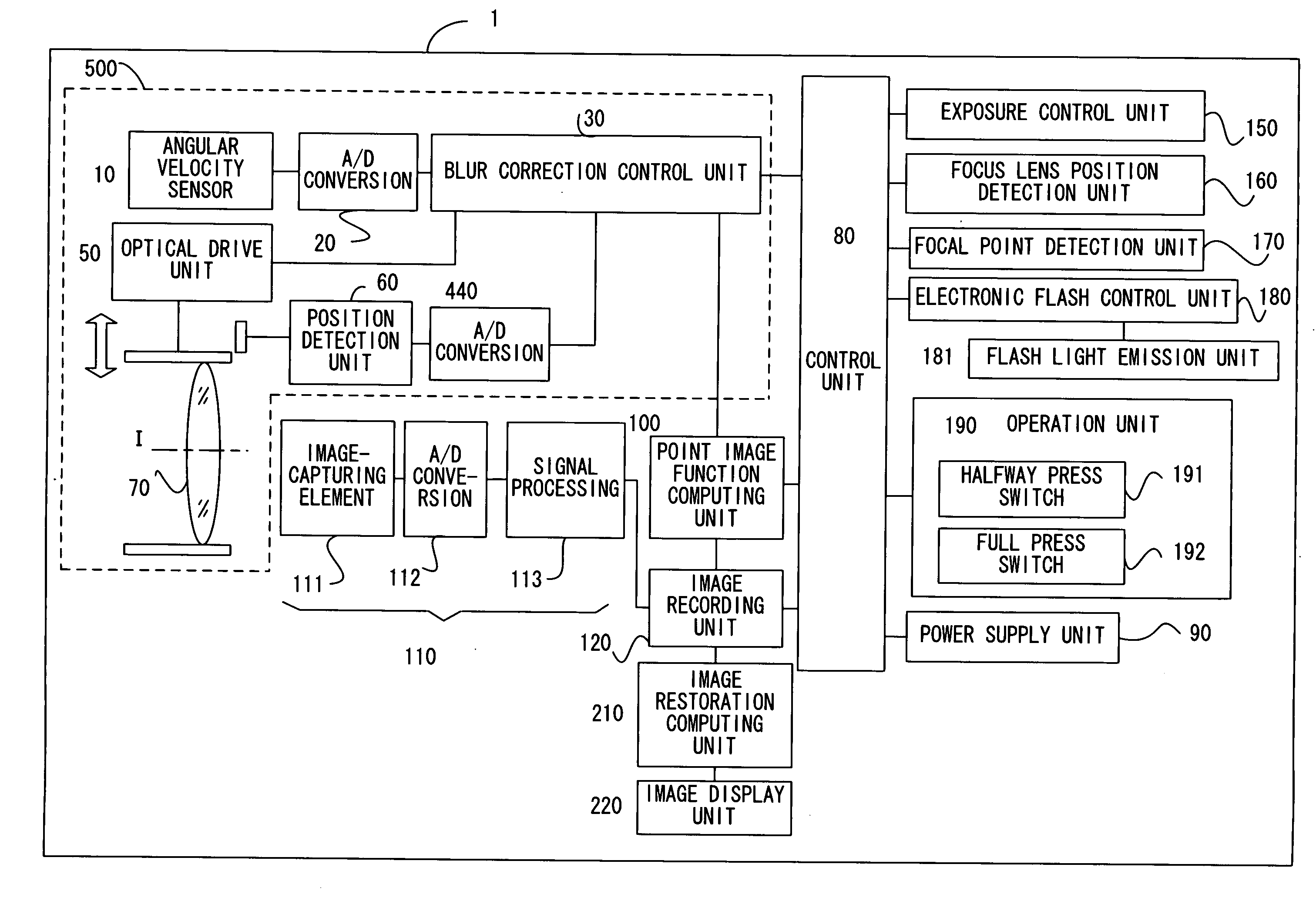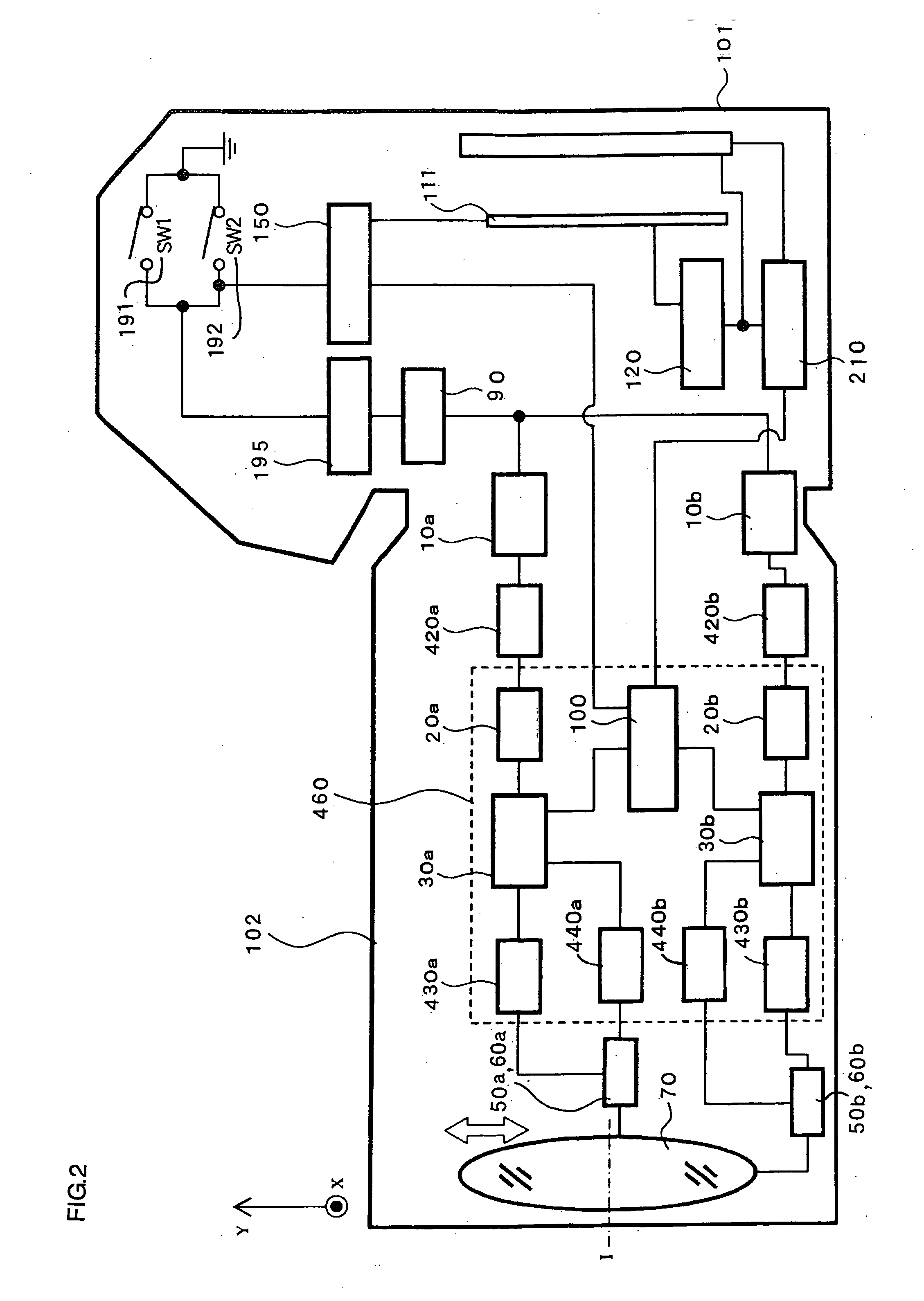Blur correction camera system
a camera system and blue light technology, applied in the field of blue light correction camera system, can solve the problems of inability to inability to fully recover the raw image, and inability to detect errors, etc., to achieve a large amount of information, reduce the information volume, and reduce the information volume
- Summary
- Abstract
- Description
- Claims
- Application Information
AI Technical Summary
Benefits of technology
Problems solved by technology
Method used
Image
Examples
first embodiment
[0096] (First Embodiment)
[0097]FIG. 1 is a block diagram showing a system configuration adopted in a first embodiment of a blur correction camera according to the present invention.
[0098] The blur correction camera 1 achieved in the embodiment constitutes a camera system having an optical blur correction function and is capable of image restoration. FIG. 2 is a diagram of a block configuration that may be adopted in the blur correction camera 1 realized as a single lens reflex camera that allows the use of interchangeable lens barrels. As shown in FIG. 2, the camera system includes a camera body 101 and a lens barrel 102.
[0099] The blur correction camera 1 is a digital still camera that electronically captures an image and includes an optical correction system (or a blur correction optical system) 500.
[0100] Angular velocity sensors 10 in the optical system 500 constitute a vibration detection unit that detects a vibration to which the blur correction camera 1 is subjected, as an...
second embodiment
[0163] (Second Embodiment)
[0164] In this embodiment, the system configuration of the first embodiment is modified by adding a blur correcting operation selector switch 194 and a signal flow control unit 452.
[0165]FIG. 9 is a block diagram showing the system configuration adopted in the embodiment, and FIG. 10 is a diagram showing the block configuration adopted in the system. The same reference numerals are assigned to components having functions similar to those in the first embodiment to minimize the need for a reputed explanation thereof.
[0166]FIG. 11 is a block diagram illustrating the operation executed at the blur correction control unit. FIG. 11 shows the signal flow control unit 452 installed to switch on / off a blur correcting operation when the output from the reference value computing unit 31 is provided to the point-image function computing unit 100.
[0167] The blur correcting operation selector switch (VRSW) 194 is operated to switch on / off an optical blur correcting o...
third embodiment
[0202] (Third Embodiment)
[0203] A third embodiment includes an image restoring device and a camera body provided independently of each other. The same reference numerals are assigned to components having similar functions to those in the first embodiment to minimize the need for a repeated explanation thereof.
[0204] The following is a detailed explanation of the embodiment of the present invention, given in reference to drawings and the like. FIG. 14 is a block diagram of the system configuration adopted in the third embodiment of the blur correction camera according to the present invention.
[0205] The blur correction camera body 1 in the embodiment adopts a structure achieved by adding a function correcting unit 105, an interface unit 130 and an image restoration decision-making unit 140 in the structure in the first embodiment, with an image restoration computing unit 210 constituting part of an image reproduction device 2, which is a separate device independent of the camera bo...
PUM
 Login to View More
Login to View More Abstract
Description
Claims
Application Information
 Login to View More
Login to View More - R&D
- Intellectual Property
- Life Sciences
- Materials
- Tech Scout
- Unparalleled Data Quality
- Higher Quality Content
- 60% Fewer Hallucinations
Browse by: Latest US Patents, China's latest patents, Technical Efficacy Thesaurus, Application Domain, Technology Topic, Popular Technical Reports.
© 2025 PatSnap. All rights reserved.Legal|Privacy policy|Modern Slavery Act Transparency Statement|Sitemap|About US| Contact US: help@patsnap.com



